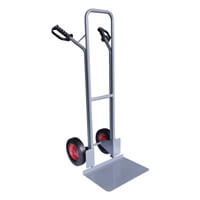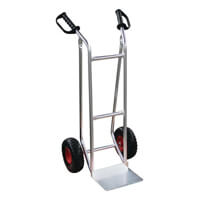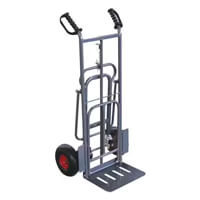When you need to manually transport bulky items across large areas, a sack truck can be the ideal solution. Although simple in design, sack trucks are built to sustain objects that carry a lot of weight and mass. They make it much easier to move heavy items around any large areas such as a warehouses, while also helping to prevent any injury or damage to the user, the surrounding area and the object in the process.
Using a sack truck is nearly always safer than moving the item manually yourself, especially if the object in question is heavy or excessively large, but how you operate a sack truck should be addressed with care. Prior to moving anything using this type of handcart, it’s important to consider a number of safety measures to prevent getting yourself stuck in a tricky situation midway through moving an item.
Before operating a sack truck, assess the load, plan your route and check the brakes (if the sack truck you’re using has this feature), check that the wheels are moving properly and are not wonky or unbalanced and ensure that the truck does not show any signs of damage and is in working condition. Before loading, it is essential that you also find out the safe working load (SWL) for that specific truck and decide whether you need to take additional measures to secure the load you are transporting to the sack truck itself. What you’re transporting to the sack truck itself. Finally, it’s a good idea to assess the area you’ll be moving across before starting, checking that the wheels won’t be damaged by the terrain or surface involved and removing any obstacles blocking the way.
What is a sack truck?
Also often referred to as hand trucks among many different names, a sack truck is a form of transportation for heavy objects. They’re used primarily in environments where heavy items and products need to be moved frequently, such as warehouses, making the process of moving awkward items easier by supporting the shape, size and weight of the product without overloading the person operating the truck.
A basic sack truck usually takes the form of a traditional ‘L-shaped’ design. Typically, a strong sheet of metal can be found at the bottom of the truck to support the load whilst transporting the load while a metal or wooden backboard is placed at a right angle from this base. Two wheels are situated at the bottom of the backboard, leaving an opportunity to support the truck when it’s tilted backwards in preparation for moving. The final notable feature are the two long bars pointing upwards, usually with rubber grips on the handles for extra stability.
While this is the typical design of a sack truck, you can get different types which facilitate the transportation of different items. For instance, some come with a ‘P-shaped’ handle for additional support when moving heavier items, others possess a wider sheet of metal for larger items and some are able to fold away for people who want to store away their sack truck with ease. There are also different variations of sack trucks, such as appliance trucks for lifting fridges, freezers, washing machines and dishwashers, and steel load luggers for transporting objects that are best lying flat.

What is a sack truck used for?
Popular in working environments that require frequent transportation of heavy items on mass, sack trucks provide a reliable and safer solution for moving items . Not only can they move items that you might find difficult without the use of a sack truck, but they cater to moving more than one item at a time, especially in cases of transporting several heavy boxes at once.
As you can potentially carry more than one item at once, using a sack truck could mean a safer solution for transporting items enhancing productivity where you work. Sack trucks are also easy to use, with a basic ‘L-shaped’ design to make the process of using one simple and safe.
All you need to do to operate a sack truck is gently lift the item so it slots onto the sheet of metal, attach any extra rope, bungee ties or string to keep the item secured to the trolley, and slowly lift it backwards (roughly 45°) until it’s resting on the backboard and arms of the truck. When you’ve reached the area you want the item to go, you can push the trolley until it’s upright and slide the item off the metal sheet onto the floor.


Heavy Duty



Leave a Reply
You must be logged in to post a comment.